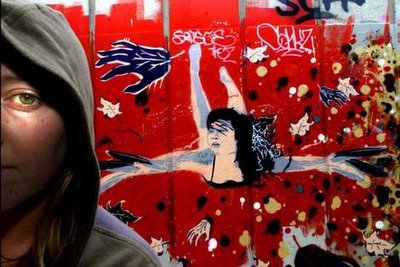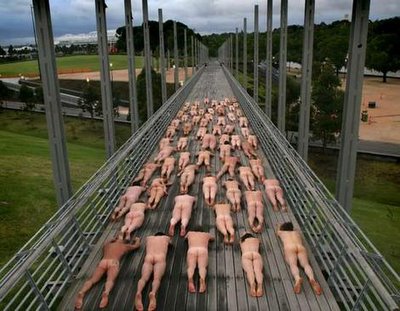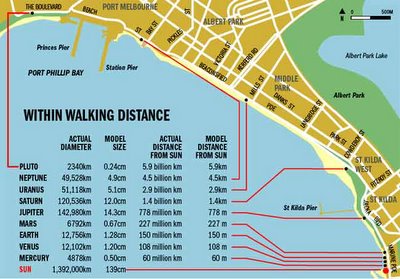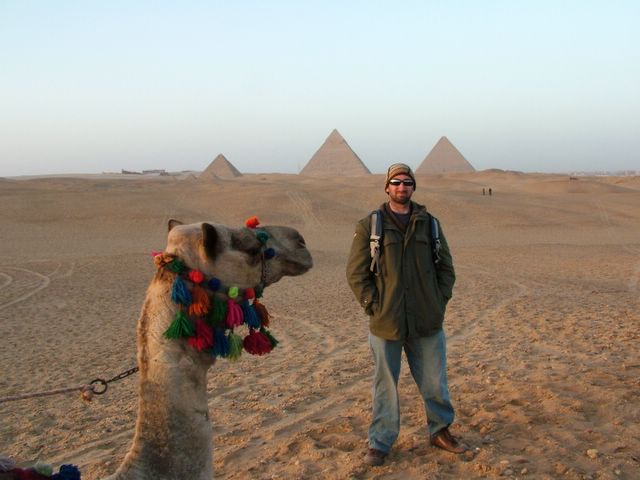Our colourful underbelly
http://www.theage.com.au/articles/2005/12/03/1133422148230.html?page=fullpage#contentSwap1

Stencil artist Vexta with her diving woman, on the walls of the St Kilda junction underpass. "I don't want to live in a city that's really bland and covered in grey and brown and advertising."
Photo: Cathryn Tremain
By Gabriella Coslovich
December 4, 2005
AS IF Melbourne wasn't labouring enough under the weight of labels and the burden of trying to live up to them: the world's most liveable city, Australia's sporting mecca, and arts capital to boot. Another has just been thrown into the mix, and it's the kind of tag to chill the establishment's heart as the city barrels towards the Commonwealth Games with the grand ambition of presenting itself to the world as tidy-town.
The latest claim to greatness? Stencil graffiti capital. No, not of the nation. Of the world. So say the authors of a new book, Stencil Graffiti Capital: Melbourne, which documents the city's vibrant stencil art scene and profiles some of its leading players — the likes of Ha-Ha, Psalm, Meggs, DLux, Meek, Vexta, Civilian. The city's commuters, shoppers and roamers may well recognise these names, having stumbled upon the signatures and their adjacent handiwork in secluded laneways and underpasses, on tucked-away walls and along railway corridors — sprawling tracts of lively images and text that break the monotony of brick-and-mortar canyons.
For those residents who embrace street art as a reflection of the city's witty, creative and socially aware underbelly, here finally will be a label worth subscribing to, an attribute that sets Melbourne apart in an idiosyncratic, non-conformist way.
Then again, there will be plenty of graffiti-loathers ready to condemn a book that celebrates such illegal activity and has the gall to rate Melbourne as the world's top destination for stencil art.
When it comes to graffiti, it seems the world is divided into those who see it as a menace to society, a sure trigger of escalating crime and falling property values, and those who view it as a vital element of a city's urban fabric and consider the best examples of it as an exciting part of contemporary art practice.
Should Melbourne care that it's pronounced stencil graffiti capital?
"You might not care, but you don't really get the choice because it's going to be there whether you like it or not. You're going to come across it in the street … it's going to arrest your attention," says Jake Smallman, a 27-year-old Melbourne graphic designer and the book's co-author.
We meet at Fitzroy's Kent Street Cafe, a laid-back, double-storey haven furnished with mismatched retro furniture and oozing inner-city cool. Stencil artists Ha-Ha and DLux used to run the "Early" gallery upstairs showing works influenced by street art.
"Although it was small, there was often huge openings with people spilling out onto the footpath," Smallman says.
The gallery has gone, but the cafe's spacious toilet — mirror included — is blanketed in scrawls, drawings, stickers, stencils, a rough and ready temple to graffiti.
It's the perfect setting to meet Smallman and three of the artists featured in his debut publication — Meek, Civilian and Vexta, the sole woman profiled in the book.
Three years in the making, the 150-page book features 500 colour photographs and is the first to extensively document Melbourne's stencil art scene. Ironically, it took a small New Jersey publisher, Mark Batty, to recognise the value of the project. While books on graffiti and street art seem to be flavour of the month with publishers, Batty says Smallman and co-author Carl Nyman's proposal stood out for two reasons.
"One, their idea was well focused — stencil graffiti in Melbourne. Two, they were not approaching the subject from the outside; they're both very much entrenched in this community."
The research, says Smallman, was exhausting, requiring blind faith, optimism and perseverance through numerous setbacks and pitfalls. The result is an informative and entertaining book that documents the evolution of stencil art on Melbourne's streets, from 1999, when stencils bearing the moniker Psalm began to appear, to today's stencil graffiti boom.
Over the past six years, the stencil graffiti scene has flourished to the point that it has gained a certain mainstream acceptance and is being discussed in art and design journals and major newspapers, exhibited in national galleries, and appropriated by shrewd advertisers and corporations wanting to imbue their product with instant street credibility. Today, the world's most influential website on stencil graffiti, Stencil Revolution, comes out of Melbourne.
Smallman and Nyman, a Swedish graphic designer who was drawn to Melbourne because of its street art scene, met at what is believed to be the city's first gallery exhibition of stencil art at the Hush Hush art space, in Melbourne's graffiti-covered Hosier Lane.
Both had been independently photographing Melbourne's stencil graffiti, and soon they were forging plans for a book.
"We just realised that there was nothing anywhere in the world like the quality of the stencils that there are here, and the energy," Smallman says. Their book is divided into themes — skulls, politicians, faces, music, symbols, cartoons, animals, sexy ladies, horror, text. And it is interspersed with a series of candid profiles which give an insight into the diversity of Melbourne's stencil artists, their personalities, styles, influences and motivations — from the audacious Ha-Ha, who boasts that "the risk of getting caught is the ultimate thrill, it's better than sex", to the socially conscious Vexta, whose first stencil was an image of a two-year-old human skeleton, with the text "This is what a war victim looks like".
Tourism authorities and government bureaucrats seem to be in constant brainstorming mode trying to find ways to lift a city's profile and marketability. Architectural landmarks such as the Harbour Bridge or Federation Square, and natural wonders feature heavily in the drive for tourist dollars. Yet a city's unsanctioned marks, the surprises lurking in the undergrowth, the expressions of its subcultures (that is, its people), also capture the imagination of tourists and citizens, and speak volumes about the pulse of the city beyond the official channels.
To borrow a catchphrase from the Melbourne subculture website ThreeThousand, "the best things in life are often hard to find". Especially so for a city such as Melbourne which cannot boast the spectacular natural beauty of, say, a Sydney, or the awesome architectural history of a Rome.
Head down to Hosier Lane on a weekend and you will see how the swirling, wild creations of the city's stencil and street artists engage the mainstream. It's not just wannabe rock stars seeking street cred for their new CD cover who converge on the lane to be photographed against the gritty, glorious backdrop of street and stencil art. Bridesmaids in long satin dresses and stiff up-dos and brides swathed in clouds of tulle, teeter precariously in their stilettos on unforgiving bluestone to secure a touch of urban chic for their wedding albums.
Who needs the Harbour Bridge when your city has soul?
There's no denying the dynamism of Melbourne's street art scene. Hosier Lane and Centre Place, and Carlton's Canada Lane have become ever-evolving public galleries, tourist destinations in their own right. They've been featured in travelogues, such as Lonely Planet's Six Degrees television series.
But stencil graffiti capital? Of the world? It's a big claim. Smallman says he and Nyman came to that conclusion through extensive overseas travel and by scouring websites featuring street art from around the world.
London's street art guru Tristan Manco, whose books include Stencil Graffiti and Street Logos, vouches for the vigour of Melbourne's stencil art scene — with one qualification. "To take on the title of 'best stencil graffiti scene in the world', Melbourne would have to have a showdown with Buenos Aires in Argentina — the scene there has reached critical mass right now, with a fiery political and creative passion."
Now there's an idea, a stencil art showdown — an event for incorporation into the Commonwealth Games perhaps? It's not as outlandish as it seems.
When I mention the Melbourne City Council's recent adoption of a zero tolerance policy towards graffiti, Manco responds: "Zero tolerance does seem a little harsh — perhaps they should take a lead from Athens, which organised an Olympic graffiti event inviting such graffiti stars as Os Gemeos from Brazil."
It seems highly unlikely that Australia will be doing anything of the sort. The State Government recently announced it would provide $1 million for the creation of a specialist police taskforce to target graffiti hot spots around the city and push for convictions against graffitists in the lead-up to the Commonwealth Games.
But within the Melbourne City Council, there are voices of dissent. Greens councillor Fraser Brindley vehemently opposed the adoption of zero tolerance towards graffiti. He denounces it as a short-sighted, narrow-minded desire to sanitise the city for the Commonwealth Games.
"There's a lot of chest-beating going on and a lot of simple thinking about the way the city should present itself. Prohibition is not working and anyone who thinks beating your chest louder will rid the city of street art is deluded," he says.
"A lot of the laneways have been reinvigorated by street art more than anything else and to document it (in a book) is a great idea and is reflective of its status in Melbourne," Brindley says. He warns that under the new zero tolerance policy, there is nothing to protect the prized street and stencil art in laneways such as Hosier Lane and Centre Place.
Councillor David Wilson, who voted in favour of zero tolerance, does not condone the publication of Stencil Graffiti Capital: Melbourne. He's not averse to buying it, though. In fact, he probably will: "That's not condoning it, that's just information gathering."
Yet even Wilson, who denounces graffiti as illegal, "personally" hopes that the property owners of Hosier Lane and Centre Place will seek council approval to retain the street art there. He disagrees that there's anything contradictory about his stance.
But the State Government and Melbourne City Council's hardline approach to graffiti will backfire, according to Smallman and the stencil artists and result in a proliferation of one of the most detested forms of graffiti — tagging, which can be done in five to 10 seconds.
STENCIL graffiti can take hours from conception to the moment of execution. The technique requires a screenprinter's skills and an artist's eye for design. Stencil artists may take a photo of the image they have in mind, or they may draw it themselves, or find it in a magazine or online.
Once they have their image, they then need to work out how they will turn that design into a functioning stencil. Multi-coloured images require separate stencils, to build layers of colour. The image is then transferred to cardboard or acetate. Depending on the intricacy of the design and the number of colours, it can be a complicated process, and the most arduous part is often the cutting.
"I've had this finger go numb completely for a week at a time," Meek says, indicating his index finger. One of Meek's best-known, most popular stencils is that of a busker, holding a sign saying "keep your coins, I want change". Up-and-coming community lawyer Phil Lynch, a keen campaigner for law reform for the homeless, was recently spotted in the city wearing a T-shirt with Meek's stencil printed on it.
Says Meek: "I thought a long time about that one because I didn't want to put something out that was mocking homelessness in any way, or making fun of people who have to beg. It probably took 10 hours to cut out, probably three to five minutes to put up."
To the uninitiated, three to five minutes may not sound long, but in the world of graffiti, it's a risky amount of time to be standing somewhere spray painting. Tagging, by comparison, takes about 10 seconds or less.
"I'm shitting myself most of the time I'm putting something up," Meek says. "The worry about getting caught isn't that bad; I'm more worried about a vigilante or overly aggressive cop being violent with you."
The National Gallery of Australia's curator of prints and drawings, Anne McDonald, views stencil art as the contemporary equivalent of the political posters of the '70s and '80s. Whenever she visits Melbourne, McDonald drops by Hosier Lane and Centre Place to see how the stencil graffiti scene is progressing. The gallery, she says, is considering ways of incorporating stencil art into its comprehensive collection of Australian prints.
But not everyone appreciates the artistry of street stencils. Even an image as beautiful and serene as Vexta's diving woman, created from an underwater photo she took of a friend, which is stencilled on the walls of the St Kilda junction underpass, managed to offend some small-minded passer-by, who has scrawled "f--k off hippie" on it. But that's the reality of the scene Vexta works in.
Yet that's not the worst of it, as Civilian knows. He faced the full fury of the law, after being caught by police in a disused building where an "Empty Show" — underground stencil art show — was about to be staged.
He recalls the frightening incident: "There were three of them. I was alone in an empty warehouse. They didn't let me go, they had guns.
"They were yelling at me, really angry, and they ripped up all the stencils around me," Civilian says.
"I was doing a lot of political stuff at the time, and they hated it (screaming) … 'How dare you criticise the army! That's my family! They defend our country, if it wasn't for them we'd be living under a different regime, how dare you!' (They were) like yelling in my face. It was quite scary."
Civilian is a gentle, softly spoken 27-year-old, who studied environmental management and science at university. He worries about how the new anti-terrorism laws, particularly the sedition provisions, might affect street artists.
But fear of the authorities won't stop the stencil artists from hitting the streets.
Meek, in any case, has little respect for the dictates of our Federal Government.
"At the time when I was really getting heavily into stencil graffiti, our Government was sending troops to Iraq, which was breaking international law.
"So I was, like, I don't really care about breaking our Government's laws if they're basically breaking laws."
As for Vexta, there are plenty of things she finds far more offensive than stencil art.
"I don't want to live in a city that's really bland and covered in grey and brown and advertising. I never said it was OK to put a billboard on the top of Brunswick Street, so who's to say that I can't put up a small A4 size image in a back laneway?"







